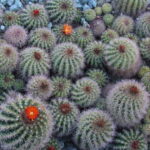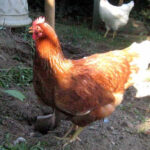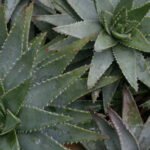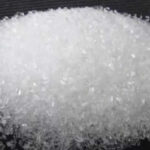One of the most common pests of indoor plants is mealybugs. These scale insects aren’t a huge issue in some cases, but infested plants can experience myriad problems as mealybugs feed on them. It’s important to act appropriately even in light infestations so they don’t become heavy infestations.
Any pest management strategy, even with houseplants should include integrations of biological control, cultural practices, and insecticides. By knowing which species of mealybugs you’re dealing with, you’ll know how to get rid of mealybugs in the most effective ways.
So let’s discuss mealybugs, their preferred hosts, and what their damage looks like. Then we’ll cover mealybug control, so you can have happy and healthy houseplants, and outdoor plants alike.
Subscribe to the Epic Gardening Podcast on iTunes or Spotify
Mealybugs Overview
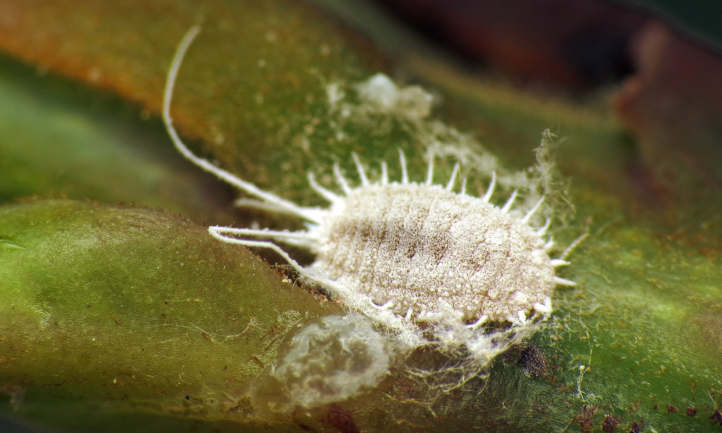
| Common Name(s) | Mealybugs, longtailed mealybug, long-tailed mealybug, citrus mealybug, Gill mealybug, Comstock mealybug, grape mealybug, solenopsis mealybug, obscure mealybug, tuber mealybug, coconut mealybug, pineapple mealybug, and others |
| Scientific Name(s) | Pseudococcus longispinus, Ferrisia gilli, Pseudococcus comstocki, Planococcus citri, Pseudococcus maritimus, Phenacoccus solenopsis, Pseudococcus viberni, Pseudococcus affinis, Maconellicoccus hirsutus, Nipaecoccus nipae, Dysmicoccus brevipes, Pseudococcus brevipes, Dactylopius brevipes, and more |
| Family | Pseudococcus |
| Origin | Worldwide |
| Plants Affected | A majority of food and ornamental plants and trees. Typically not grasses. |
| Common Remedies | Rubbing alcohol, insecticidal soap, neem oil, and beneficial insects including ladybugs, lacewings, and the mealybug destroyer. |
What Are Mealybugs?
Mealybugs are soft members of varying genera of scale insects that feed on the sap of plants. Unlike other scale insects, they look ilke little cotton balls crawling on varying host plants. Mealybugs produce sticky honeydew that attracts ants, and causes sooty mold infections. This is especially detrimental to sensitive plants. Most of the time, small populations of mealybugs are easy to manage. But on a mass scale, they’re a problem.
Unlike their relatives, armored scales, they don’t have a hard shell for defense. Mealybugs on plants have a waxy coating that deters predators, which makes it possible for them to survive just as easily. You may wonder, where do mealy bugs come from? Do mealy bugs fly? Usually they come from infested nursery plants or from other plants outdoors. This answers the “Where do mealybugs come from?” question. You may also wonder are mealybugs harmful to humans? Not technically. Mealybugs damage plants, not humans.
Types of Mealybugs

There are over 2200 species of mealybugs that feed on certain plant species, but only a portion are considered garden pests. Let’s discuss a few mealybug species that are most common.
Pseudococcus longispinus, ‘Longtailed Mealybugs’
A common greenhouse pest or nursery pest, these have 17 pairs of long tail waxy filaments which extend from their rear, often longer than their body. The long tailed species dine on tropical plants such as bromeliads, coleus, crotons, and even the hoya plant.
Ferrisia gilli, ‘Gill Mealybugs’
Stone fruits such as apricot tree or peach tree host the gill mealybug, as do some nut trees like the pistachio tree or almond tree. Grapes and deciduous ornamentals may also be at risk. These pinkish soft scales are usually covered in white wax, and sometimes have a covering of long, crystalline filaments.
Pseudococcus comstocki, ‘Comstock mealybug’
The Comstock mealybug is common in the San Joaquin Valley area of California, and primarily feeds on lemon trees. Similar in many ways to the citrus mealybug, it has a pair of medium-length spines protruding from its rear.
Planococcus citri, ‘Citrus Mealybugs’
Citrus mealybugs don’t have the same long tail that Pseudococcus longispinus has, but they do impact similar plants. Indoor ornamentals (like African violets) and citrus trees host the citrus mealybug. The citrus mealybug has short filaments of equal length distributed around their bodies, and occasionally a dark stripe running down their back.
Pseudococcus maritimus, ‘Grape mealybug’
Grape mealybugs favor grapevines. Visually similar to the obscure mealybug (mentioned below), identify them by their defensive reddish orange honeydew excretions. The grape mealybug resides mostly in central and northern California.
Phenacoccus solenopsis, ‘Solenopsis mealybug’
This highly common mealybug is found on a variety of crops. Among those are food crops like tomatoes, potatoes, melons, and eggplant. These mealybugs have a long, oval-shaped body which is dark, and covered in a white waxy covering.
Pseudococcus viberni, ‘Pseudococcus affinis’, ‘Obscure mealybug’, ‘Tuber mealybug’
The obscure mealybug is can be found in California, as well as South America, Australia, New Zealand, Iran, and other places. This long, oval-bodied mealybug has small filament protrusions from its sides. Its white to greyish-white body usually has a white or off-white waxy coating. Plant hosts include various tuber crops, vegetables, and fruits.
Maconellicoccus hirsutus, ‘Pink hibiscus mealybug’

This mealybug doesn’t limit itself to just hibiscus plants. They’re also fond of fig and citrus trees, grapes, and several ornamentals. They’re coated with a white waxy secretion. Nymphs look almost like a mealy wax patch.
Dysmicoccus brevipes, ‘Pseudococcus brevipes’, ‘Dactylopius brevipes’, ‘Pineapple mealybug’
The pineapple mealybug is one of the lesser-known mealybugs in most of the United States. It’s pink or pinkish-orange, and feeds on pineapples, citrus, coffee, cotton, and many Ananas-species trees (including bananas). It’s found in all of the Hawaiian islands. Their feeding sites include leaves, fruit, or the base of their host plants. They cause pineapple wilt (also referred to as mealybug wilt or edge wilt) and mealybug stripe.
Nipaecoccus nipae, ‘Coconut mealybug’
The yellowish-orange coconut mealybug is found on palm trees, avocados, and some flowering tropical plants. The wax they produce is an unusual bright yellow color, and when excreted, forms a series of pyramid-like spikes that protrude from their bodies. Adults are larger with more pronounced spikes and appear more yellow due to their thicker wax coating. Nymphs have less wax buildup and look orange.
Planococcus ficus, ‘Vine mealybug’
This mealybug is highly detrimental to California vineyards. They’re also found in the Mediterranean, South Africa, Mexico, and parts of Asia. Their bodies are ovular, distinctly segmented, and covered in a fine white wax that extends into spines on their sides. They also consume apple, beet, potato, willow, and walnut trees.
Ferrisia virgata Cockerell, ‘Striped mealybug’
This mealybug is common across the world. They seem indiscriminate when it comes to their hosts. Varying crops, including ornamentals, vegetables, field crops, and fruit host these striped scale insects. Also heavily segmented, their bodies are covered in a white powdery wax and have two vertical stripes that run from head to tail-end.
Phenacoccus madeirensis, ‘Madeira mealybug’
Yet another widespread species, Madeira mealybugs are found all over the world on seemingly unlimited members of 45 plant families. Their bodies have fluffy secretions on their tops, and are white-gray.
Rhizoecus hibisci, ‘Root mealybugs’
Root mealybugs stand apart from most species as they feed on plant roots underground. While they do have a waxy coating, they lack the spines that many other mealybugs have, giving them a smooth appearance. They’re found in tropical environments in East Asia, Puerto Rico, and Florida. There they consume a variety of tropical plants.
Life Cycle of Mealybugs
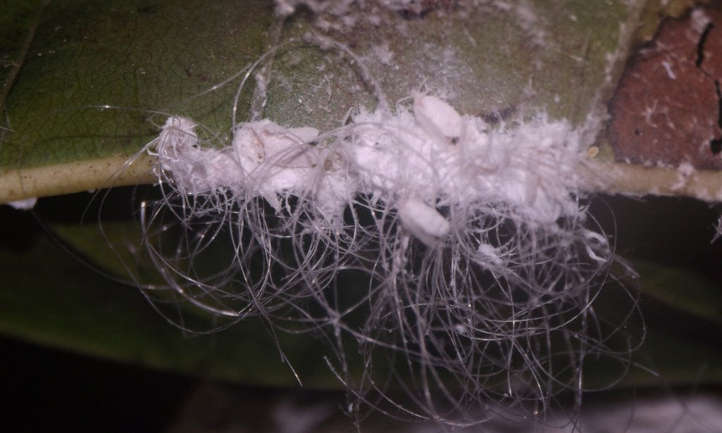
With the exception of the longtailed species, the mealy bug life cycle consists of an egg stage, a nymphal stage sometimes referred to as the “crawlers” stage, and the adult mealybug. For the longtailed mealybug, the life cycle includes only the crawler stage and adult, as adult females give birth to live young.
Most species of adult mealybugs lay eggs inside of a cotton-like pouch which protects egs and nymphs from the elements. This cottony egg mass is often mistaken for downy mildew. Once the adult female completes egg laying, she dies off. The average adult female can lay 300 to 600 mealybug eggs. The eggs hatch within 5 to 10 days in good weather conditions. Inclement weather may delay hatching as the egg sac protects young mealybug colonies. Newly hatched nymphs, or “crawlers”, have vestigal legs and move around. These nymphs travel and spread to other plants.
This crawler phase lasts for 6 to 9 weeks, as nymphs mature. They then briefly pupate and emerge as an adult. Females remain stationary on their host plant (although they can still move). Male nymphs do not feed after pupation, and live for only a couple days. Male mealybugs also mate with any adult females they find before expiring. The cycle continues as the next series of adult mealybug females lays eggs or live young, and then die off. Multiple generations of white cottony masses hatch per year.
Identifying Mealybugs and Their Habitat
Mealybugs tend to live in and around their hosts. Different types prefer leaves, stems, the plant’s base, the roots, and even the fruit in some cases. Some forms of these scale insects build up at the joint of leaf and stem, where they have some shelter. Others merely secrete extra protective wax and live openly on cactus pads or leaves where they are more exposed.
It’s likely that a buildup of waxy secretion will be visible, especially if eggs are present. Cottony, glassy filaments of wax and cotton-like egg pouches may also be on the plant. In situations where multiple plants of the same species are close together, it’s common to see initial damage on the outer plants. As an infestation spreads, the pests work their way inward.
All mealybugs excrete honeydew. Heavily infested plants may exhibit sooty mold fungi which develops as a result. If you’re wondering whether or not you’re dealing with mealybugs, look for white fuzzy bugs on plants that secrete honeydew, giving the plant a sticky coating.
Mealybugs consume the saps or juices of the plant on which they attach themselves. They do not typically chew leaves, but a large infestation can cause leaf yellowing. Withered leaves and falling leaves are common. Fruit may drop prematurely, and stunted plants may not be able to produce new leaves. A large enough infestation will cause reduced plant vigor, plant decline, and eventually plant death.
Mealybugs As Disease Vectors
It’s especially important to control mealybugs because they can spread diseases to their hosts as they feed. This means otherwise healthy plants may contract a disease and die even when mealybug populations are low. As mealybugs feed, they produce honeydew. The excretion then becomes sooty and molds, infecting plants with the mold which covers leaves and eventually stems and shoots. Another disease spread by these white fluffy bugs is grapevine leafroll virus. They also cause pineapple wilt diseases.
Controlling Mealybugs
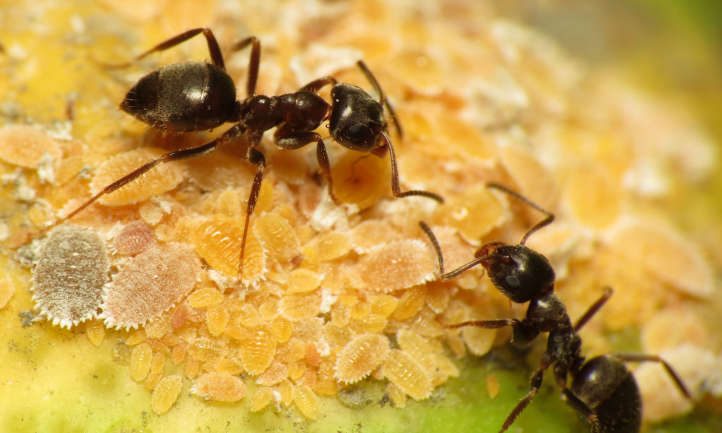
Now that we’ve discussed the mealybug life cycle, and how to identify them, let’s talk about mealybug treatment. Remember, an integrated approach to pest management works best for both mealybugs on houseplants and those living in greenhouses or outdoors.
Cultural Control
Avoid overwatering and excess fertilizing of outdoor and indoor plants. Ensure your container plants have adequate drainage holes. Plants that are too nutrient-dense are targets, as are ones which are saturated with lots of plant juices. Blast mealybugs and other scale insects off your plants with a hard spray of water. While crawlers may be able to go back up the plants, the adults will not. They will die out in a couple of days from starvation.
Kill mealybugs with alcohol. For those still on the plant, dip a cotton swab or q-tip in rubbing alcohol, or isopropyl alcohol and pop each little bit of cottony material off into a bowl of soapy water. Then wipe down the whole plant with an alcohol-soaked cotton swab. This treatment is best used for house plants, as alcohol can damage outdoor plants in direct sunlight.
These soft scales (just like armored scales and aphids) are farmed by ants who provide shelter, protection, and cleanliness. In return, the ants consume their honeydew. While not all mealybugs have ant companions, many do. Controlling ants outdoors, especially around potted plants and landscape plants, will remove one of the variables for mealybug infestations. If using chemical ant bait isn’t your style, treat the mound with boiling water, or scoop a little bit of ants from another mound and let the two populations duel it out.
Biological Removal of Mealybugs
Beneficial insects that are the natural enemies of mealybugs help a great deal. Ladybugs eat the eggs and the nymphs. Lacewings also eat the eggs, but control both crawlers and the adult scale. An uncommon, but equally-effective member of the predatory insects category are mealybug destroyers, Cryptolaemus montrouzieri. These small beetles were originally transported to the US from Australia in the 1890’s to help clear up citrus mealybug infestations. They’re useful in greenhouses as well as outdoors and eat all life stages.
Parasitic wasps are also great predators that remove mealybugs from plant parts they consume. Remember, if you’re working with natural enemies, provide habitat to ensure they stick around. New plants and soft growth are sensitive to these insecticides and may not be able to withstand them.
Insecticidal Removal of Mealybugs
Before you spray to rid your plant of female citrus mealybugs or male citrus mealybugs, use insect growth regulators to determine whether or not chemical control is needed. First, determine which of the cottony cushion scale insects are alive by flipping them over with a needle. They’ll look full and round, or will bleed if they’re alive. Count at least 25 of the mealybugs present, then multiply the number of live ones by 4. If dead scales outnumber live ones, you can control mealybugs with horticultural oil or other organic methods to reduce populations gradually over time without damaging beneficial populations of insects. Some chemical controls can be intensive, and should be used with caution.
Insecticidal soaps – especially those labeled ‘mealybug spray’ – are an excellent way to get rid of female nymphs and adult female mealybugs as well as other species of insect pests. You can find insecticidal soaps at any gardening-related store. Spray all plant parts and reapply in 7 to 10 days if plant growth hasn’t improved and there are still mealybugs present. Neem oil for mealy bugs is used as a preventative, but it’s also a viable treatment. Use them in the same manner as insecticidal soaps and other horticultural oils.
While you can use systemic insecticides, these should be a last resort. It is far easier to encourage predators like the mealybug destroyer, or use organic controls.
Preventing Mealybugs
To keep mealybugs at bay, spray your plants once a week with a solution of neem oil in water. If you coat all plant surfaces, the neem oil will slow or stop feeding on your plants by a wide variety of pests. In addition, the oil coats eggs and crawlers smothering them.
Since mealybugs and ants have a symbiotic relationship, it’s also essential to eliminate ants if you spy any around your mealies. Keeping the ants at bay reduces the chance that they’ll be protected and cared for, which makes it easier to eliminate them entirely. Check out our post on how to get rid of ants naturally for good ways to control them!
Frequently Asked Questions

Q: How do you stop mealybugs?
A: There are plenty of ways! Check the Control section above.
Q: What kills mealybugs instantly?
A: Alcohol-dipped q-tips allow you to pop these bugs off into soapy water. Instant kill!
Q: What is the cause of mealybugs?
A: They love to eat. Can you blame them?
Q: How do you kill mealy bugs naturally?
A: The Control section above has a number of biological and organic methods listed. Check those out!
Q: Are mealy bugs hard to get rid of?
A: Not necessarily. They’re easy to control as long as you stay on top of them.
Q: Can mealybugs live on humans?
A: While they potentially could, they wouldn’t have anything to eat. It’s unlikely this has ever happened.
Q: Do mealybugs live in soil?
A: Root mealy bugs do!
Q: What is the white cotton looking stuff on plants?
A: It could be mealybug eggs or the bugs themselves.
Q: Should I throw away a plant with mealybugs?
A: Unless the entire plant is infested or is covered with their sooty mold there’s no need to throw it away.
Q: Are mealy bugs harmful to humans?
A: No, not really. While they do spread some viruses to grape plants and can transmit other plant diseases, they don’t bite humans. However, some people do have a sensitivity to the waxy secretions they produce, and it can cause skin irritation. Wash your hands after you come into contact with them to be sure you don’t have a problem.



